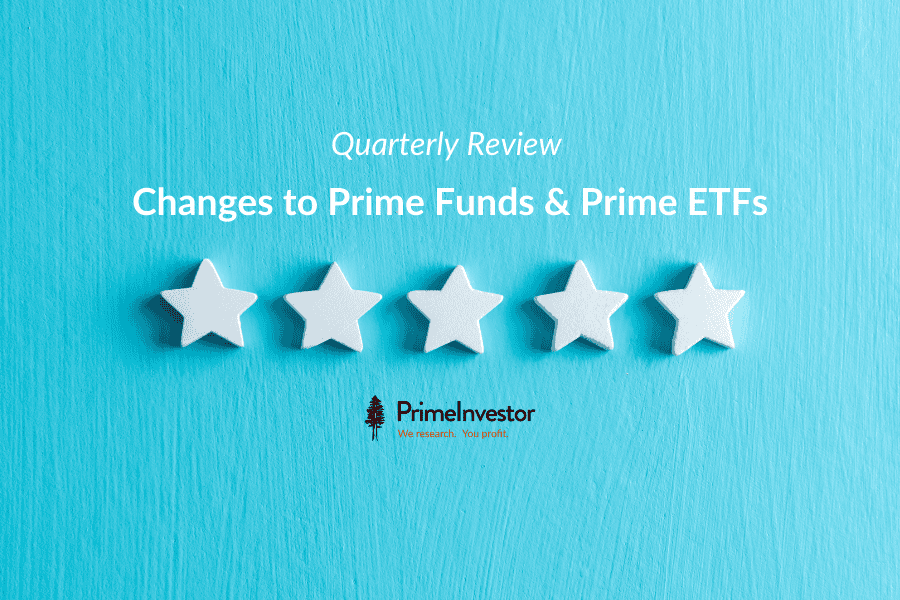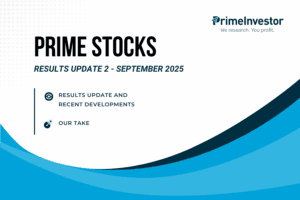Prime Funds is our list of recommendations in equity, debt, and hybrid mutual funds that are worth investing in. Prime Funds narrows down your choices from the thousands of funds that there are into a concise list of funds that span different styles. Prime Funds are selected based on performance, portfolios, and investment strategies.
In this review, we have kept changes to a minimum. Please go through the report in detail.

About Prime Funds
Prime Funds is our list of best mutual funds across the equity, debt, and hybrid categories. We use Prime Ratings, our fund ratings, as a first filter. We then apply qualitative analysis to arrive at our fund recommendations. Prime Funds is an enduring list of funds that you can use at any time. You will always find a fund to meet any goal you’re looking to meet.
Different categories: Prime Funds are separated into buckets, based on risk level in equity & hybrid funds and timeframe in debt funds. Each of these draws from different SEBI-defined categories. We have classified them in a more user-friendly way than using the several dozens of SEBI categories. We do not go only by Prime Ratings but look at other factors as well to narrow the list and make the choices easy for you.
Different styles: In Prime Funds, we’ve aimed at providing funds that follow different strategies for you to mix styles and diversify your portfolio with ease. The ‘Why this fund’ for each Prime Fund will brief its strategy, why we picked it, and how to use it in your portfolio.
Direct plans: We have specifically given the direct plans in Prime Funds. If you wish to know whether it is ok for you to use the regular plan of the fund, check our Portfolio Review Pro tool periodically to know if you are with expensive regular plans.
Quarterly review: Our aim in reviewing the Prime Funds list every quarter is to ensure that we don’t miss any good opportunities that are coming up and we are not holding on to funds that are slipping. When we remove funds from the Prime Funds list, we tell you exactly what to do if you have invested in these funds. Funds we remove do not immediately call for a sell – it is just that they have slipped in performance marginally or there are better alternatives now. Unless our review tool says such funds are a ‘sell’, you can hold them (refer to our article on when to sell funds)
Using Prime Funds: You don’t need to hold every Prime Fund nor add any new fund we introduce to the list. Unless it fits your overall portfolio/strategy, or there is something lacking, there is little need for you to go on adding funds. Our idea of covering them in detail through some of our calls is to let you know the strategy, style, and suitability in different portfolios. It is not a specific call to buy right away, unless we mention that it is a ‘tactical’ or ‘timing’ call. If you need to build a portfolio using Prime Funds, use our Build Your Own Portfolio tool to make this easy for you.
Equity funds
Stock markets have bounded past every potential obstacle, from a startling election outcome to delayed interest rate cuts globally to concerns of froth and expensive valuations in many pockets. In the past few quarterly reviews in Prime Funds, we have been highlighting the following points:
- There has been a divergence in the performance of funds especially in where mid and smallcap stocks come into play.
- Funds that bet on market-favourite themes have clocked very strong returns while those turning cautious in terms of stock choices or profit booking have been subdued.
- While the overall indices have rallied smartly, especially in the mid-and-smallcap space, funds are not fully reflecting these returns. This happens owing to the nature of stocks that have participated in the rally; as a bull run continues on unabated, stocks with questionable quality come to the fore. Many funds tend to avoid such stocks or at best have low allocations. Therefore, where indices have a heavy share of mid-and-smallcap stocks, fund performance has often been lacklustre.
These trends continue to hold. This is the nature of the current market and needs to be weathered. As we recently explained in our report on markets at a peak & what you should do, continue with your current asset allocation, trim excesses where warranted and avoid making investment calls based purely on recent returns.
We have also been cautious about making too many changes based on the current scenario. We continue to provide leeway for Prime Funds returning below benchmarks if their underlying portfolio is sound and appears well-positioned to deliver over the medium term, or if performance shows signs of picking up in shorter-term return trends. In this review, we have made just two changes.
Equity – Aggressive, Active
In this category, we are removing SBI Smallcap and shifting it to a Hold. We had retained the fund in the Prime Funds list for several quarters despite underperformance against peers and benchmark. We took this call as the fund had taken a conservative approach, shifting 10-14% of the portfolio into cash and taking longer-term calls in portfolio stocks. It had also bounced back from an earlier bout of underperformance. This apart, its consistency held strong compared to both category and the Nifty Smallcap 250 on the longer 3-year returns periods.
However, SBI Smallcap has slipped back below category and this gap is starting to widen again. On longer-term returns as well, the fund has begun to slip. The fund’s conservative approach can hold it in good stead should a steep correction take place in the smallcap space – but until such time, with the rally in the segment continuing, further underperformance can pinch. This apart, the fund has strict restrictions on investments, which limits its usability for most investors and portfolios.
Hold all investments made in SBI Smallcap and do not exit. Start fresh SIPs in the other smallcap funds in the Equity – Aggressive Prime Funds set if you specifically want a smallcap fund. Otherwise, you can pick any fund in the Prime Funds set.
We are not adding any fund to replace SBI Smallcap. We do not see merit in adding any of the other smallcap funds as performance has been uneven for those not already part of Prime Funds. Current market conditions also do not line up for taking higher-risk bets in the smallcap space.
Equity – High risk turnarounds
In this Prime Funds category, we are adding Kotak Multicap. This is not a turnaround fund; rather it is a new fund that does not have an established track record. The fund will complete 3 years only in September this year and it is unrated in Prime Ratings. However, we are introducing this fund to Prime Funds in our endeavour to catch performers early – which is the idea behind this High Risk Prime Funds category.
Kotak Multicap, in its short history, has beaten the Nifty 500 and the multicap category average all the time on a 1 year rolling basis since its inception. The outperformance over category has also been healthy at an average of about 6 percentage points. While it has been more volatile, it has still been adept at capturing upsides during the market rally in the past 3 years.
The fund uses a proprietary model of mean reversion to decide which market cap to go overweight on and momentum to decide the duration of position in stocks. Its sector allocations can deviate from the benchmark, which helps introduce diversification in your portfolio. Kotak Multicap also has a low portfolio overlap with other funds in its category.
This fund can be used as the high-risk allocation in your long-term portfolio, to aid overall portfolio returns. It can also be used as a route to add mid-and-smallcap exposure to a portfolio without going for pure smallcap or midcap funds. However, keep allocation to Kotak Multicap within 5% given its short history and higher risk; we may make quicker calls with this fund if performance does not sustain.
Separately, in a call in June, we removed Quant Active from this Prime Funds set (and Quant Absolute from the Hybrid – Moderate Risk set) owing to governance concerns. We have explained this already in the call published and in your several queries after that, so we’re not getting into any more explanation here.
Equity – Moderate
In this Prime Funds category, we are not adding or removing any fund. However, we wanted to highlight the performance of Canara Robeco Flexicap. We have called out the performance of this fund in earlier reviews as well, and it is among the least returning ones in this Prime Funds set.
Canara Robeco Flexicap has been part of Prime Funds for years now. It principally follows a growth-style approach, which has hurt performance as value-based strategies came to the fore; in 2023 and 2022, the fund saw spells of underperformance but has usually managed to narrow the gap.
Currently, Canara Flexicap trails the Nifty 500 TRI by about 4 percentage points. This extent of lag is not new, and the fund has both seen and recovered from such dips earlier. A few calls have weighed on performance, such as HDFC Bank (top weight) along with others such as Infosys, Bajaj Finance, and Reliance Industries. The fund’s current portfolio is made up of a good mix of quality names and with a good sector allocation across finance, auto OEMs, industrials, consumption, energy, and pharma. This can hold up returns going forward. Therefore, we’d prefer to wait out the fund for performance improvement. It also provides good strategy diversification in this Prime Funds set, since most other funds we have are tilted towards value.
Debt funds
We are making no changes in any Prime Funds set in debt funds. The funds we have in each set remain above-average performers in their respective categories and there are no other better opportunities to add at this time. Our additions in earlier reviews have covered the different strategies that can be undertaken in debt funds, from accrual based funds to gain from the overall higher rates available now to gilt funds to play duration at the time the rate cycle turns down.
Prime ETFs
Prime ETFs is our list of recommended ETFs in equity, debt, and gold. We look at multiple factors to draw up this list, ranging from short-term and long-term tracking error, expense ratio, trading volumes and usefulness of the index in a portfolio. In this review, we have made only one ETF addition.
Equity - High Risk
In this Prime ETFs set, we have added ICICI Prudential BSE 500 ETF. The BSE 500, like the Nifty 500, is a broad-market index that represents over 90% of the listed universe. The BSE 500 is a good route to hold the entire market across large-cap, mid-cap and small-cap stocks. It is a stiff benchmark to beat, even for active diversified funds.
The ICICI ETF has seen an improvement in traded volumes, which has helped keep tracking error contained. The ETF’s market price also does not deviate much from the underlying NAV. The ETF can be used as the high-risk allocation in a portfolio.
Strategy & Thematic
In this Prime ETFs set, we have not added any ETF. However, we want to highlight the Mirae Asset S&P 500 Top 50 ETF. This ETF tracks the top 50 stocks within the S&P 500 (US index). The ETF saw a brief period of high tracking error and significant deviation between market price and NAV between March and June. This has abated in the past few weeks and tracking error appears to be back within reason – higher tracking error is par for the course currently, given the restrictions funds and ETFs have in investing internationally.
We will keep watch on how tracking error develops, but as of now, it remains a good option to invest in US markets amidst the current RBI-imposed restrictions that have closed off many international funds.
You can find the full Prime Funds list here.
You can find the full Prime ETFs list here.




12 thoughts on “Quarterly Review – Changes to Prime Funds & Prime ETFs”
Is it possible to add entry date/quarter for the each fund to the prime funds list? This will help to know from when funds starts appearing in primefunds list.
Thanks for the suggestion. In the redesign of pages under WIP, the new ones added for the quarter will be distinct. Also, the new dashboard under works will also show such latest calls. Vidya
Are you exploring other quant based theme’s? From tata AMC or kotak AMC. This is given that quant as a theme though gives good return unless pi team feels the risk is not worth the reward
So far, we have not seen pure quant funds doing well consistently – they tend to do well only in phases and its hard to predict when that will be. In quant funds, a good track record across cycles is necessary to see how the model works over time. So we don’t generally recommend them – will have to see how the newer ones do. thanks, Bhavana
thank you for the guidance! As guided by PI earlier, I have sold quant active. and sitting on cash. Is Kotak multicap a good replacement to add to the portfolio in its place? What do I need to know if I making this switch?
If you are looking for high risk, yes. You need to know that this fund ahs a limited track record and we may choose to give an exit call if the bet does not work. In other words, it is a tactical call like the quant one. So don’t keep it as part of any core portfolio and let exposure be limited. Vidya
yes, have seen it. however that segment does not call out the current view on the themes – buy or hold.
BFSI is a buy is what i can make from above note. but no clarity on IT, Pharma etc buys given earlier, if they continue to be a buy. also at a point, there are way too many themes suggested to invest in, and this itself is getting to be like a Diversified Mutual Fund in a way, as its covering pretty much all sectors! just a feedback, pl dont take it otherwise. i just feel the X factor in thematic funds needs to be there. Exit calls will be the key here, even if upside is there.. but not as significant.
We see your point and you are not wrong 🙂 We have picked themes that are best in each category but if you read all our mails, we specifically call out sector opportunities. At this point Banking and discretionary consumption are sectors we are positive on and as a dark horse IT. The other funds are meant for people who ask for which fund to choose in a specific sector. Vidya
thank you Vidya for your response.
My submission is, entry is great, look at exiting calls too. For eg: The stock exit calls are good, you exit when a certain stocks is multiplied..similarly if you feel sectors are overvalued, it would be nice to take a call to suggest to exit..so that funds can be rotated too a better sector. What are the house views on Infra/power sector?
(on a seperate note. Dark horse IT is interesting, but would you suggest Franklin Tech or ABSL Digital (mid/small vs large basically))
Yes, we concur on the need to be active in sector fund calls. We have given book profit and re-entry calls in sectors such as commodities when we call them out specifically. Such a need hasn’t risen for the others thus far. We will definitely give more ‘definitive calls’ in sector funds 🙂 On tech – please check the 2 funds in prime funds an read the ‘why this fund’ to see which one fits you. Those are the only calls we have in that space. thanks, Vidya
thank you! Strategy & Thematic part is not clear, which sectors/themes can be added or booked profit in?
Prime Funds (and Prime ETFs) has a separate section called Strategy & Thematic, under Equity. These themes are ones we have a positive view on, and the funds can be invested in. For these funds, we give book profit/exit calls when we see the run in the theme drawing to a close. – thanks, Bhavana
Comments are closed.